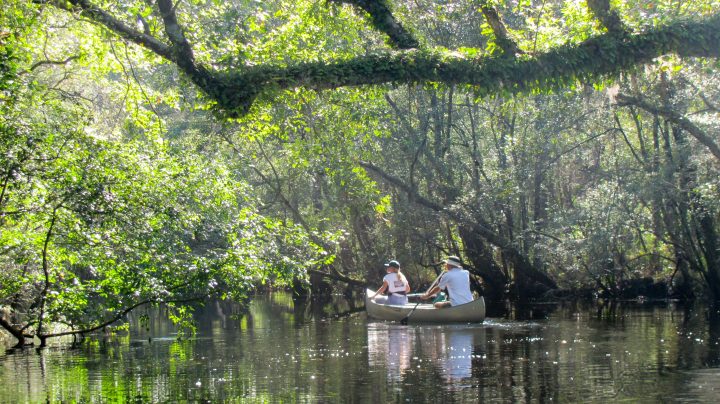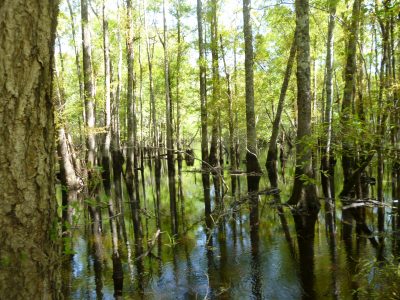
COLUMBUS COUNTY — Earlier this year, nearly 3,000 acres along the Waccamaw River was protected thanks to the North Carolina Coastal Land Trust and a host of conservation partners in an effort initiated by a $1 million court-ordered hog farm pollution settlement from 2012. In the weeks since, environmentalists have had more reasons to be grateful for the preservation work.

“A month after completing the Waccamaw purchase, Hurricane Florence ravaged the coast, and our preserve was under water,” said Camilla Herlevich, executive director of the Coastal Land Trust. “We know that preserving, reclaiming and restoring our natural wetlands can’t prevent the damages of catastrophic storms like Florence and Michael, but it certainly can lessen the impacts — by spreading rising floodwaters out over larger areas, and by slowing down and filtering floodwaters as they move downstream.”
Supporter Spotlight
And that’s what’s happened. The land that was undeveloped had a better ability to mitigate the damages from the storm, said Cara Schildtknecht, the Waccamaw Riverkeeper.
“I was able to visit the northern Waccamaw recently,” she said. “The river levels are getting back to normal and the water chemistry is getting back to normal.”

Easing potential storm damage wasn’t the first reason that the area was protected. Perhaps higher on the list, when it isn’t hurricane season, are the many endemic species, unique habitats and critical wetlands of the Waccamaw. It all began with the settlement of a Clean Water Act violation brought by the U.S. Attorney’s Office for the Eastern District of North Carolina against Freedman Farms and Columbus County hog farmer Barry Freedman, accused of dumping 324,000 gallons of untreated hog waste into a tributary of the Waccamaw in 2007. He pleaded guilty to negligent violation of the law and was ordered to pay the $1 million.
“That was the catalyst. And instead of using that money outright, we leveraged it by working for other grants,” Herlevich said. “You’re in a much better position for many of these grants if you have matching funds.” Project WOW, for Waters of Waccamaw, was years in the making but the end result, completed with the help of a dozen other organizations, has a much larger impact in terms of land saved, she said.
“Since 2013, we utilized the $1 million court award to secure more than $5 million in matching grants,” she said. The thousands of acres include blackwater bottomland hardwood forests, cypress swamps, and 7 miles of Waccamaw River frontage.
Supporter Spotlight
“The area has a rare water chemistry and many of the plants and animals that flourish in the Waccamaw are found nowhere else on Earth,” she said. “It’s a treasure chest of natural wonders.”
“What we’re excited about is that it covers so much of the area around the river,” Schildtknecht said.
Although the Waccamaw, which runs about 140 miles across southeastern North Carolina and eastern South Carolina, is considered a clean river, there is a persistent worry about the effect that development can have on water quality. This conservation effort should help, she said, and draw more attention to the river.

“I think in North Carolina, the river doesn’t get a lot of attention. But it is such a beautiful, wild, blackwater river,” she said.
Part of what makes this ecosystem unique is the limestone that underlays the basin. The alkalinity is one reason there’s such a high level of species diversity and endemism. The Waccamaw Basin supports six endemic fishes including the Waccamaw silverside and the ironcolor shiner, several rare mollusks and is a system with 62 documented fish species. Rare plant species include the greenfly orchid, Plymouth gentian and swamp forest beaksedge.
The 3,000 acres is the third of three acquisitions in the area, Herlevich said. The Land Trust also closed on 670 acres in October 2014 and 670 acres in May 2016. The Coastal Land Trust purchased the property managed by Campbell Global, a global investment manager focused on timberland based in Oregon, with offices in Wilmington.
“We were able to work with them in terms of what would be better for conservation and what tracts worked better for their goals,” Herlevich said.
She added that another success of Project WOW is that it joins lands to other conserved properties. These 3,000 acres are located directly across the river from the Columbus County and Juniper Creek Game Lands, which encompass more than 28,000 acres. It also connects to 17,000 acres of The Nature Conservancy’s Green Swamp Preserve, resulting in one of the largest conservation corridors in the state.
“By linking there’s a much bigger protected corridor,” she said. “Bigger is better in terms of habitat, especially for larger animals.” Although smaller tracts of protected land have their place, conservation theory shows that larger animals need more acres to thrive and larger tracts result in less interference with people, she said.
The Coastal Land Trust transferred about a thousand acres of the property to the North Carolina Wildlife Resources Commission as an addition to Columbus County Game Lands for public game lands, which will be managed through timber thinning, prescribed fire, and restoration of distinctive remnant forest types to benefit wildlife such as white-tailed deer, wild turkey, wood stork and Swainson’s warbler, according to Brian McRae, land and water access section chief for the commission.
The Coastal Land Trust will retain the remaining 2,000 acres for management as a nature preserve. Herlevich said the organization hopes to restore and preserve stands of Atlantic white cedar and is leasing the property to a hunt club, which will help it maintain and monitor the property.
The Coastal Land Trust secured grants from a total of 12 different funders including the U.S. Fish and Wildlife Service’s North American Wetlands Conservation Act program, National Fish and Wildlife Foundation, North Carolina Clean Water Management Trust Fund, North Carolina Wildlife Resources Commission, Fred and Alice Stanback, the state’s Environmental Enhancement Grant Program, Open Space Institute, Enviva Forest Conservation Fund, The Conservation Alliance and the Merck Family Fund.
Considering recent hurricanes, Herlevich said the organization plans to continue to conserve this critical area.
“We’d like to protect much more land along the Waccamaw — for wildlife, flood control, and clean water.”








